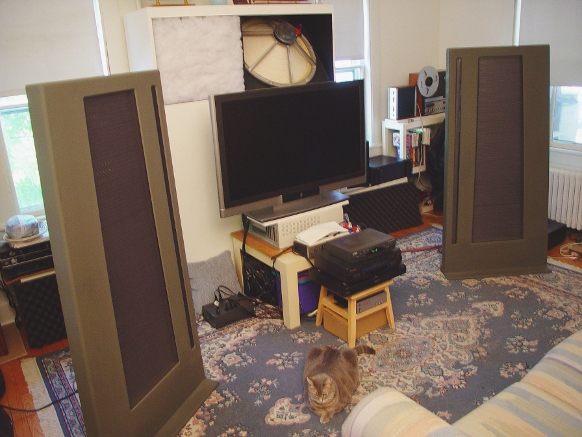| For many years I was caught up in
designing and building audio gear. My efforts included a couple of
full-range speaker systems, a couple of very large
"transmission-line" subwoofers, a smaller commercial subwoofer,
a couple of different electronic crossovers, a phono preamp, a mic preamp,
and a rather strange tone-arm (the long, articulated "Praying
Mantis" was described in a construction article in "The Audio
Amateur", I think as "A Perfectionist's Tone Arm", in 1996). At one time I had about half a ton of audio
gear in my little house - and I had designed and built everything in the
stereo system except the turntable platter and drive and the dynamic
speaker drivers. Later I replaced the main speakers with Quad and
Acoustat electrostatics, and then Apogee ribbons (which I still have).
One of the full range speaker systems I built was a three-way with a
transmission-line bass, enclosed in rather large and heavy boxes with
triangulated-interiors and 1.5" thick walls. The largest
transmission-line subwoofer I've built was featured in a construction article
as
"The Big Bass Box" in "The Audio Amateur" magazine in
1978, available on CD at -- www.audioxpress.com/magsdirx/backissues/BISAAM.htm. I
still use the "smaller" of two transmission-line designs using the 24" Hartley driver
(this one was modified to allow clean 3/4" excursions and it was set
inside the smaller cabinet at an angle instead of on top), pictured below sitting between the Apogee Duetta ribbon
panels. The "small" transmission-line enclosure (standing at the
left in the corner in the second photograph) is the last of the "Aardvark Quark
Audio" subwoofers. One of these was "reverse-engineered"
and published with plans by Nick Huntington at -- www.t-linespeakers.org/projects/nick/aqa.html (on David Dlugos' "Transmission Line Speaker Page" site, at -- www.t-linespeakers.org), though it is without the design for the electronic crossover-EQ sold with the box. (This last AQA T-line box, with 1" clean-excursion 12" driver and "flame" walnut front [which measured -3db at 23 cps, flat above with the matched crossover] is available for sale for $1200 with the crossover). I used to crack windows with these when testing them at 18 cycles at 150 watts input (but don't tell my landlady in Seattle how those windows got cracked...!;-). Probably my best speaker system consisted of a horizontal array of four Quad electrostatics, a pair of EQ'd KEF T-27 tweeters on poles, and the larger Hartley-driver T-line (with the parts of each set of a pair of Quads with the tweeter between carefully aimed at, and spaced equally from, its receiver-ear location - resulting in a large near-arc of sound sources properly placed for the same sound arrival time at each set's ear about 7' away). The stereo precision was quite astonishing, though the "sweet spot" was exceedingly tiny...!;-). This system could also reproduce good square waves continuously over a wide frequency range, indicating good phase and frequency response - and this system sounded good on a very wide range of recordings (in both quality and type), an indication of its smoothness and neutrality. I miss this system, but it was fun to have owned it once... Below are a couple of photos of my current Audio-Video setup (with cat...;-).
Behind the left speaker above, you can see part of my last Aardvark Quark subwoofer, and behind the right Apogee panel in the photos above you can see my old Revox and DBX recording combination which I used to record concerts in Seattle (using the simple mic preamp I designed, and omni mics made from $1.50 Panasonic modules mounted in brass tubes in triples - which sounded remarkably good!). Perhaps sometime I will get around to transferring the most interesting recordings to CD (I have some wonderful theater organ recordings, a recording of some pieces by Alan Hovhaness with AH playing and his wife singing, many recordings of reproducing pianos playing rolls made by long-dead composers and pianists on recording pianos, a recording of a Satie mass, and much more...). Musical interest led me
to try electronic music composition in the original Moog factory |
